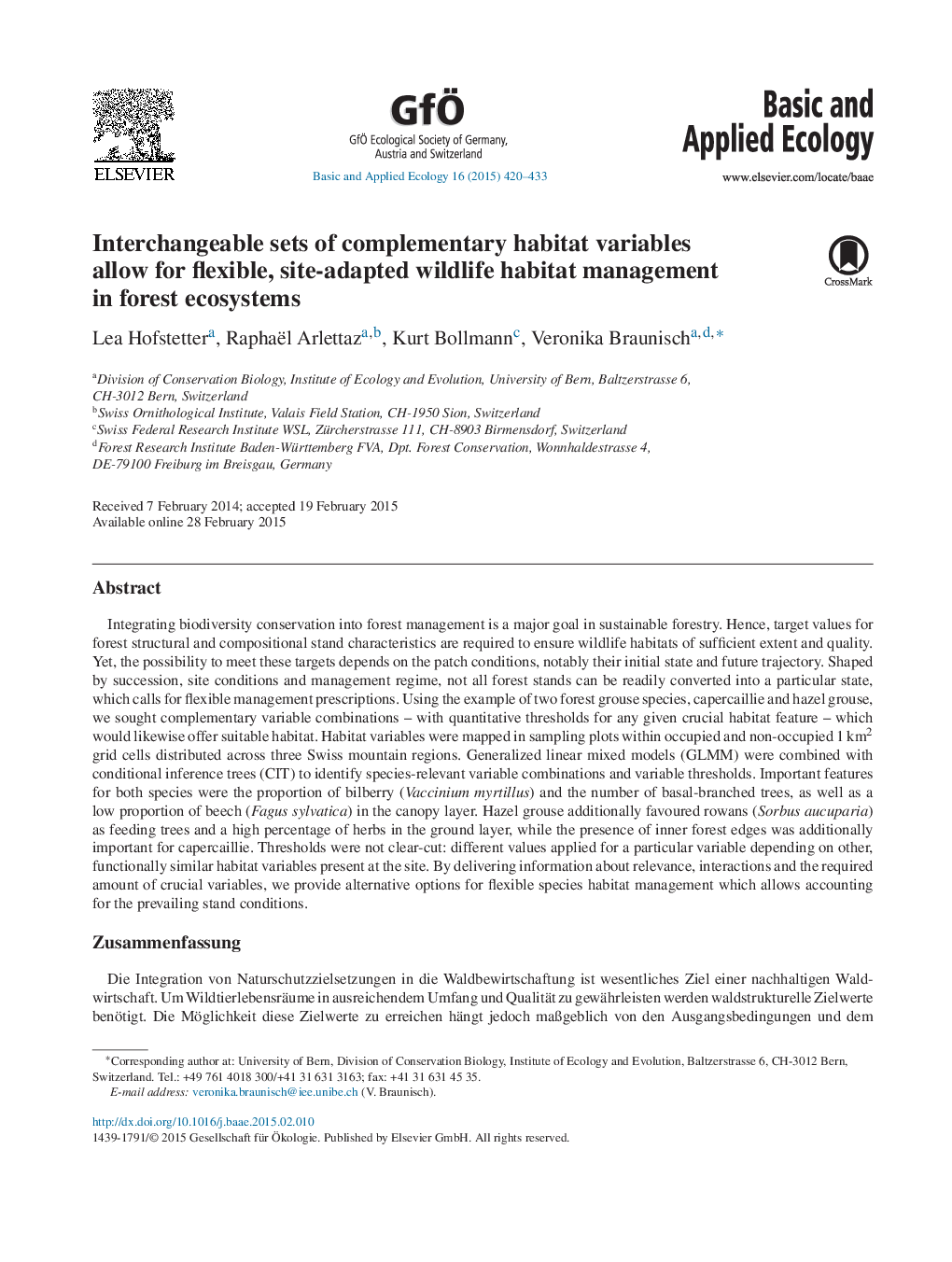| کد مقاله | کد نشریه | سال انتشار | مقاله انگلیسی | نسخه تمام متن |
|---|---|---|---|---|
| 4384074 | 1304387 | 2015 | 14 صفحه PDF | دانلود رایگان |
Integrating biodiversity conservation into forest management is a major goal in sustainable forestry. Hence, target values for forest structural and compositional stand characteristics are required to ensure wildlife habitats of sufficient extent and quality. Yet, the possibility to meet these targets depends on the patch conditions, notably their initial state and future trajectory. Shaped by succession, site conditions and management regime, not all forest stands can be readily converted into a particular state, which calls for flexible management prescriptions. Using the example of two forest grouse species, capercaillie and hazel grouse, we sought complementary variable combinations – with quantitative thresholds for any given crucial habitat feature – which would likewise offer suitable habitat. Habitat variables were mapped in sampling plots within occupied and non-occupied 1 km2 grid cells distributed across three Swiss mountain regions. Generalized linear mixed models (GLMM) were combined with conditional inference trees (CIT) to identify species-relevant variable combinations and variable thresholds. Important features for both species were the proportion of bilberry (Vaccinium myrtillus) and the number of basal-branched trees, as well as a low proportion of beech (Fagus sylvatica) in the canopy layer. Hazel grouse additionally favoured rowans (Sorbus aucuparia) as feeding trees and a high percentage of herbs in the ground layer, while the presence of inner forest edges was additionally important for capercaillie. Thresholds were not clear-cut: different values applied for a particular variable depending on other, functionally similar habitat variables present at the site. By delivering information about relevance, interactions and the required amount of crucial variables, we provide alternative options for flexible species habitat management which allows accounting for the prevailing stand conditions.
ZusammenfassungDie Integration von Naturschutzzielsetzungen in die Waldbewirtschaftung ist wesentliches Ziel einer nachhaltigen Waldwirtschaft. Um Wildtierlebensräume in ausreichendem Umfang und Qualität zu gewährleisten werden waldstrukturelle Zielwerte benötigt. Die Möglichkeit diese Zielwerte zu erreichen hängt jedoch maßgeblich von den Ausgangsbedingungen und dem Entwicklungspotential eines Waldbestandes ab. Je nach Sukzessionsstadium, Standortsbedingungen und Bewirtschaftungsform können nicht alle Bestände gleichermaßen in einen gewünschten Zustand überführt werden. Dies macht flexible Managementvorgaben erforderlich. Am Beispiel von zwei sympatrischen Raufußhuhnarten, Auerhuhn und Haselhuhn, ermittelten wir Kombinationen komplementärer Habitatvariablen und zugehöriger Schwellenwerte, die gleichermaßen geeignete Lebens-raumbedingungen bieten. Hierfür wurden Flächen mit und ohne Artvorkommen in drei Bergregionen der Schweiz verglichen und artrelevante Variablen, Variablenkombinationen sowie Schwellenwerte durch Generalisierte Lineare Gemischte Modelle und conditional inference trees (CIT) identifiziert. Wichtige Lebensraummerkmale für beide Arten waren der Anteil der Heidelbeere (Vaccinium myrtillus) sowie die Anzahl tiefbeasteter Bäume und ein geringer Anteil Buche (Fagus sylvatica) in der Baumschicht. Das Vorkommen des Haselhuhns wurde zusätzlich durch die Anzahl an Ebereschen (Sobus aucuparia) und einen hohen Anteil an krautigen Pflanzen in der Bodenvegetation bestimmt, Randlinien zu offenen Flächen im Wald waren ein wichtiger, zusätzlicher Habitatfaktor für das Auerhuhn. Die ermittelten Schwellenwerte für Habitatvariablen waren meist nicht klar definiert, vielmehr galten unterschiedliche Werte abhängig davon, welche anderen, funktional ähnlichen Habitatmerkmale in einer Fläche vorhanden waren. Neben der Identifikation artrelevanter Habitatvariablen kann die Bereitstellung alternativer Variablenkombinationen und kombinationsabhängiger Schwellenwerte eine wichtige Grundlage dafür liefern, Managementmaßnahmen flexibel an die in einem Waldbestand gegebenen Ausgangsbedingungen anzupassen.
Journal: Basic and Applied Ecology - Volume 16, Issue 5, August 2015, Pages 420–433
